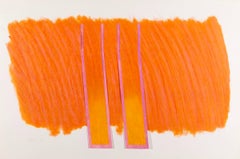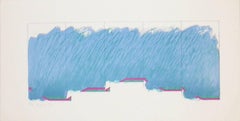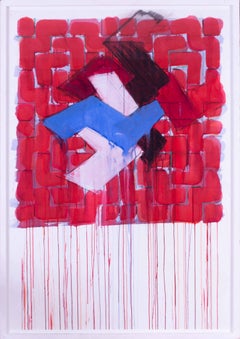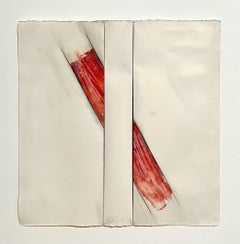Richard Smith
English, 1931-2016
Charles Richard "Dick" Smith was an English printmaker and painter.
He Attended St Albans School of Art followed by post-graduate studies at the Royal College of Art, London, from 1954-57. Smith shared a flat-cum-studio with Peter Blake in his second year at the RCA, and then again for two years after he left the college in 1957. When Terence Conran's Soup Kitchen opened on Fleet Street in the late 1950s, it featured a letter-collage mural by Smith and Blake. Michael Chow would later commission Smith to design installations for his restaurant in Los Angeles, and Chow and Conran have remained two of his biggest supporters.
In 1959 he moved to New York to teach on a Harkness Fellowship, staying for two years, where he produced paintings combining the formal qualities of many of the American abstract painters which made references to American commercial culture. The artist's first solo exhibition was at the Green Gallery. As his work matured it tended to be more minimal, often painted using one colour with a second only as an accent.
In trying to find ways of transposing ideas, Smith began to question the two-dimensional properties of art itself and to find ways by which a painting could express the shape of reality as he saw it. These principles he carried into his graphic work by introducing cut, folded and stapled elements into his prints; some works were multi-leaved screenprinting, and others printed onto three-dimensional fabricated metal.
Smith returned to England in 1963 - specifically East Tytherton, Wiltshire where Howard Hodgkin was a neighbour - and gained critical acclaim for extending the boundaries of painting into three dimensions, creating sculptural shaped canvases with monumental presence, which literally protruded into the space of the gallery. Evocative titles such as Panatella and Revlon, and cosmetic, synthetic colours alluded to the consumer landscapes of urban America which had proved so influential. He showed at the Kasmin Gallery, a venture between Kas and the Marquess of Dufferin and Ava in New Bond Street, throughout the 60s, more-widely known as David Hockney's first gallery.
Smith was invited to exhibit at the XXXV Venice Biennale as the official British artist in 1970. Smith taught with Richard Hamilton at Gateshead in 1965, where he met Mark Lancaster and Stephen Buckley, and again in 2000, becoming close to the artist and his wife, Terry.
By the late 1960s Smith's ambition to produce paintings which shared a common sensibility with other media, such as film and photography, began to wane and he focused on the formal qualities of painting. First exhibited in New York in 1971, the traditional wooden supports of the canvases were replaced by aluminium rods and strings, allowing them to be hung freely in response to the surrounding architecture. Smith continued in the subsequent decades to construct site-specific works in public and private spaces often hanging from the ceilings or architectural supports. He resettled in Patchogue, New York in around 1977.
Smith was awarded the CBE in 1971.| Average Sold Price |
| $1,291 |
| Styles |
| Materials |
| Related Artists |
Bright Orange Abstract 1970s Print with Pink, Bold Richard Smith Lithograph
By Richard Smith
Located in Kingsclere, GB
Sun Curtain by Richard Smith, 1971
Additional information:
Medium: lithograph on two sheets
64 x 92 cm
25 1/4 x 36 1/4 in
signed and dated in the plate
Charles Richard "Dick" Smith was an English printmaker and painter.
Smith was born in Letchworth, Hertfordshire, to Doris (née Chandler), a nurse and daughter of a chemical company director. He studied at Hitchin Grammar School and Luton School of Art. After military service with the Royal Air Force in Hong Kong, he attended St Albans School of Art followed by post-graduate studies at the Royal College of Art, London, from 1954-57. Smith shared a flat-cum-studio with Peter Blake in his second year at the RCA, and then again for two years after he left the college in 1957. When Terence Conran's Soup Kitchen opened on Fleet Street in the late 1950s, it featured a letter-collage mural by Smith and Blake. Michael Chow would later commission Smith to design installations for his restaurant in Los Angeles, and Chow and Conran have remained two of his biggest supporters.
In 1959 he moved to New York to teach on a Harkness Fellowship, staying for two years, where he produced paintings combining the formal qualities of many of the American abstract painters which made references to American commercial culture. The artist's first solo exhibition was at the Green Gallery. As his work matured it tended to be more minimal, often painted using one colour with a second only as an accent.
In trying to find ways of transposing ideas, Smith began to question the two-dimensional properties of art itself and to find ways by which a painting could express the shape of reality as he saw it. He began to take the canvas off the stretcher, letting it hang loose, or tied with knots, to suggest sails or kites - objects which could change with new directions rather than being held rigid against a wall, and taking painting close to the realm of sculpture. These principles he carried into his graphic work by introducing cut, folded and stapled elements into his prints; some works were multi-leaved screenprinting, and others printed onto three-dimensional fabricated metal.
Smith returned to England in 1963 - specifically East Tytherton, Wiltshire where Howard Hodgkin was a neighbour - and gained critical acclaim for extending the boundaries of painting into three dimensions, creating sculptural shaped canvases with monumental presence, which literally protruded into the space of the gallery. Evocative titles such as Panatella and Revlon, and cosmetic, synthetic colours alluded to the consumer landscapes of urban America which had proved so influential. He showed at the Kasmin Gallery, a venture between Kas and the Marquess of Dufferin and Ava in New Bond Street, throughout the 60s, more-widely known as David Hockney's first gallery.
After being awarded the Grand Prize at the 9th São Paulo Biennial in 1967 and important exhibitions at Kasmin in 1963, Tate in 1964, and Richard Feigen Gallery in 1966, Smith was invited to exhibit at the XXXV Venice Biennale as the official British artist in 1970. Smith was chosen by a committee of art experts, who were Director of Tate Norman Reid, art historian Alan Bowness, art collector David Thompson, the British Council’s Lilian Somerville and art historian Norbert Lynton. Smith taught with Richard Hamilton at Gateshead in 1965, where he met Mark Lancaster and Stephen Buckley, and again in 2000, becoming close to the artist and his wife, Terry.
By the late 1960s Smith's ambition to produce paintings which shared a common sensibility with other media, such as film and photography, began to wane and he focused on the formal qualities of painting. The freestanding installation Gazebo exhibited at the Architectural League of New York in 1966, and a tent project at the Aspen Design...
Category
20th Century Richard Smith
Materials
Lithograph
Horizon VI (blue, purple, green)
By Richard Smith
Located in London, GB
Edition of 75, Set of 6
33 x 71 cms (13 x 28 ins)
Category
1970s Abstract Richard Smith
Materials
Lithograph
Drawing Boards I (red / yellow)
By Richard Smith
Located in London, GB
Edition of 60, Set of 5
74.9 x 56.5 cms (29.5 x 22.25 ins)
Category
1980s Abstract Richard Smith
Materials
Etching
Bramble, 1970 lithograph by renowned British Pop art pioneer Signed/N, Framed
By Richard Smith
Located in New York, NY
Richard Smith
Bramble, 1970
Lithograph on wove paper
Signed, numbered and dated 10/75 in pencil lower left
Frame included: held in original vintage period frame
Pencil signed, dated ...
Category
1970s Abstract Geometric Richard Smith
Materials
Pencil, Lithograph
H 37 in W 31.25 in D 1 in
British Popart abstract work 'Interlocking abstract', Richard Smith, reds whites
By Richard Smith
Located in Petworth, West Sussex
This large, vibrant work exemplifies Richard Smith’s mastery of early British Pop Art, showcasing his iconic interlocking red shapes and joyful use of color and abstract form.
Richa...
Category
20th Century Pop Art Richard Smith
Materials
Watercolor, Pencil, Gouache
H 43.5 in W 30.25 in D 1 in
Original Abstract Collage Painting British American Pop Artist Richard Smith
By Richard Smith
Located in Surfside, FL
Richard Smith, British (1931-2016)
Untitled (Abstract Composition) (1976)
Gouache, crayon, charcoal and metal staples on Arches paper
Hand signed lower center
sheet: 22 x 22 inches
...
Category
1970s Minimalist Richard Smith
Materials
Metal
Four Knots
By Richard Smith
Located in London, GB
Edition of 50
71 x 76 cm (28 x 30 ins)
RSE023
Category
1970s Abstract Richard Smith
Materials
Etching
Grey
By Richard Smith
Located in London, GB
Edition of 50
60.3 x 61 cms (23 3/4 x 24 ins)
Category
1970s Abstract Richard Smith
Materials
Etching
Browse all Art from Richard Smith
Shop NowRichard Smith Sale Prices
This data represents a recent sample of sales made on 1stDibs during the specified years. All sales are anonymized.
| Sold Date | Sold Price | Category | Medium | Creation Year | ||||||||||||||||
|
| $1,291 |
Average sold price of items in the past 12 months |
| $850-$1,964 |
| Sold price range of items in the past 12 months |
Artists Similar to Richard Smith
Richard Smith art for sale on 1stDibs.
Find a wide variety of authentic Richard Smith art available for sale on 1stDibs. If you’re browsing the collection of art to introduce a pop of color in a neutral corner of your living room or bedroom, you can find work that includes elements of orange, green, blue and other colors. You can also browse by medium to find art by Richard Smith in etching, lithograph, screen print and more. Much of the original work by this artist or collective was created during the 20th century and is mostly associated with the abstract style. Not every interior allows for large Richard Smith art, so small editions measuring 5 inches across are available. Customers who are interested in this artist might also find the work of Antoni Clavé, Risaburo Kimura, and Pierre Muckensturm. Richard Smith art prices can differ depending upon medium, time period and other attributes. On 1stDibs, the price for these items starts at $216 and tops out at $11,500, while the average work can sell for $1,002.







